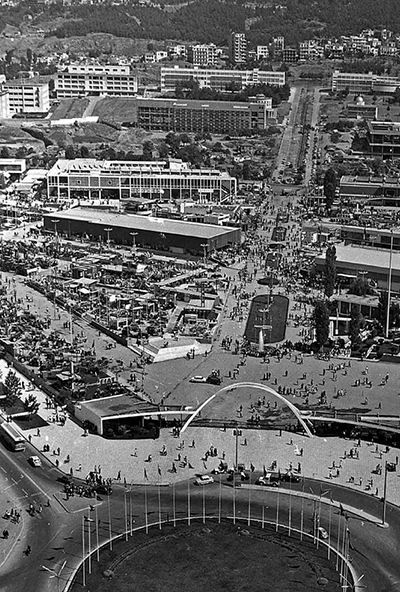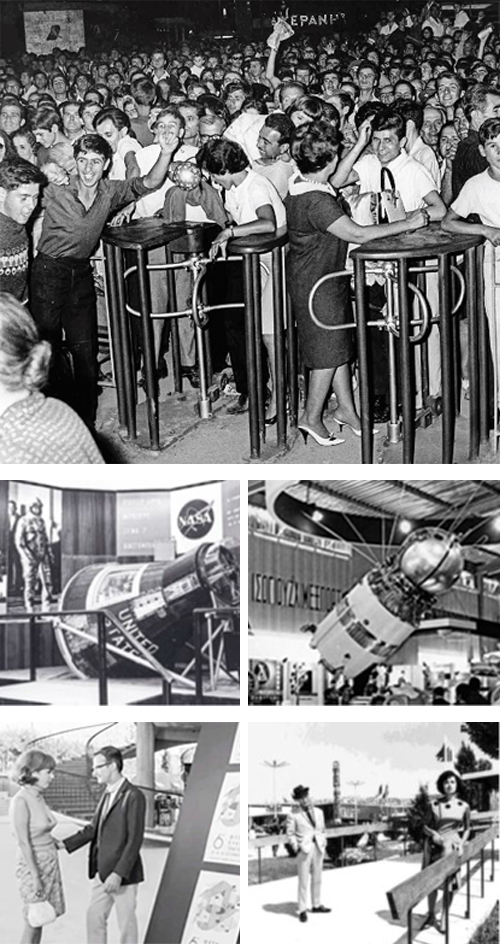History

1926 - 2023
Thessaloniki International Fair
The city of Thessaloniki has a long historical tradition in the organization of exhibitions, initially as a trade fair (Byzantine Period and Ottoman Period), then as the International Exhibition of Thessaloniki and subsequently with the addition of branch exhibitions and other events. In fact, in each of these historical periods, the targeting and orientation of the exhibition activity changed according to the needs and the prevailing conditions.
It can therefore be said that the history of Thessaloniki runs parallel to the history of the exhibition.
Video
Space and Architecture
TIF and The City of Thessaloniki: Space and Architecture.
Mr. Dimitrios Kourkouridis is speaking

Timeline
Our history

Ancient Greece
In Antiquity
The early exhibition forms in Greece appeared during antiquity in the form of trade fairs, which constitute an institution with a long history rooted in our popular tradition.
Thessaloniki since the Byzantine era, during the celebration of Saint Demetrius, organized the famous market fair "Dimitria", which was organized around the Church of Saint Demetrius in the historical center of the city.
This fair was so famous that it attracted visitors from far away.

1859 - 1888
Modern Greece
The first exhibitions in their modern form appeared in Greece, a few decades after the establishment of the Neohellenic State.
The first exhibition in Greece was organized in 1859 in Athens under the name "Olympia", as an attempt to revive the ancient Olympic Games. This particular exhibition was repeated three more times in 1870, 1875 and 1888, when the permanent venue, the well-known and emblematic Zappeio Megaro, was built.
Despite all efforts, these exhibitions did not manage to go beyond the local and national level and become established. This resulted in a city without special possibilities, but also facilities, such as Thessaloniki emerging as a center of International Exhibitions in Greece.

1925
1st International Exhibition of Thessaloniki
In the general climate of the interwar period, in 1925, just 12 years after the integration of Thessaloniki into the Greek State, the idea of establishing the International Exhibition of Thessaloniki was born by Nikolaos Germanos.
The preparation of the first TIF encountered many and important obstacles, but with the persistence of Nikolaos Germanos and the support of the local forces, the obstacles were overcome and finally on the morning of Sunday, October 3, 1926, the opening of the first exhibition took place, which took place in the Field of Areos which is located on the outskirts of the historical center of the city and just a few meters from the current location of the exhibition.
The atmosphere at this event was festive. In total, more than 600 exhibitors and 150,000 visitors participated in the Exhibition, covering an area of approximately 7,000 square meters. These figures are impressive, if we consider that the population of the city at that time did not exceed 180,000 inhabitants.

1926 - 1940
Pre-war period
In 1926, after the success of the first organization of TIF, the conflicts and disputes started again, but once again the persistence of Germanos resulted in the creation of a strong partnership of supporters of the repetition of the Exhibition.
After the 2nd organization of TIF, the exhibition is now developing into an institution for Thessaloniki, but also for the country in general. It is organized every year in September, being the economic and political event in Greece. It is constantly developing by increasing both the number of exhibitors and its visitors, while at the same time it is increasingly internationalized with ever-increasing official state participations from all over the world.
The exhibition was repeated until 1939 at the Field of Ares, while in 1940, just before World War II, it was moved to a larger space where it still operates today. The 15th TIF of 1940 was also the last pre-war exhibition, as during the war years the exhibition suspended its operation and operated substandardly.
This first period of the operation of the International Exhibition of Thessaloniki was a difficult period when the institution had to resolve many operational and organizational issues, while at the same time confronting important rivalries and personal ambitions of the economic and political actors of the time. The main goal of the first events in this period was the promotion of the Greek industry and the acquaintance of the general public with their products. These difficulties, through persistent efforts, were overcome and TIF laid solid foundations for its transformation into an important economic, political and social institution for the city and the country as a whole.

1951 - 1973
Post-war period
After the first pre-war TIF events and with a 10-year break due to the Second World War, as well as the civil war, the TIF returned strongly in 1951. The first post-war TIF event exceeded all expectations, both in terms of the participation of the exhibitors , as of course in terms of the response of the visitors.
After the first major post-war exhibition which was a great success, the TIF followed a continuous upward trajectory, both in terms of the number of exhibitors, as well as in terms of the number of its visitors, as well as official national participations. More specifically, from 1951 to 1966, TIF's visitors had tripled and we reached 1,634,542 visitors in 1966! This number was unimaginable for the time, if we take into account that the population of Thessaloniki at that time was approximately 300,000 inhabitants and the entire country was approximately 8,500,000 inhabitants! The year 1966 is also the absolute record for attendance at TIF, even to this day.
Throughout this period, the technological achievements of the various states were presented at the TIF. In fact, in many cases during this period, the most advanced technology of the time was presented at TIF, such as the types of atomic energy presented by the USA. Also in the period of the 1950s and 1960s, in the midst of the prevailing cold war climate, the USA and the Soviet Union faced TIF as a field of confrontation and a prime opportunity to demonstrate their achievements in space technology.
Additionally, indicative of the dynamics that TIF had acquired in the period 1951-1973, is the fact that several Greek films of the time had scenes inside the exhibition spaces or even their entire plot took place inside it. Characteristic examples of such films are the 1963 film, "Kati kai na kaiei" directed by Yiannis Dalianidis, as well as the 1967 film "O Anakatosouras" by Grigoris Grigoriou.

1974 - PRESENT
Industry Fairs Development Period
In the period after 1974, alongside the TIF, which continued to be organized every September, other branch exhibitions with a more specialized orientation developed. These sectoral exhibitions gathered the interest of thousands of professionals in each sector.
In particular, the first attempt to organize branch exhibitions came in 1973 with the International Fur Exhibition and the MARMIN International Exhibition. The exhibitions were a great success and in the following years, the presentation of products grouped by sector was implemented at TIF. This method eventually led to the emergence of many important industry exhibitions that developed into an institution for the country's exhibition industry. In the first years of the industry fairs, a total of 27 industry fairs emerged, while by 2009 they had reached around 20.
More generally, during the period from 1974 onwards, a significant change appears in the exhibition landscape, where a shift towards specialization, but simultaneously towards multi-functionality is recorded. In particular, on the one hand, the commercial and economic interest is focused on the sectorial specialized exhibitions, while at the same time a change in the character of the TIF is presented, which gradually acquires multifunctional characteristics, as it turns into a political, social and entertainment event.
Video
TIF and Culture
TIF and Culture: Contribution and co-operation.
Mr. Dimitrios Bruchos is speaking